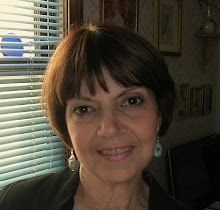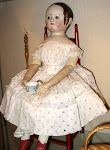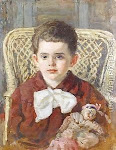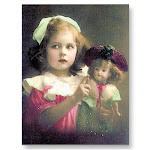 Patti as "Violetta"
Patti as "Violetta" Patti, ca. 1854
Patti, ca. 1854
She was born Adela Juana Maria Patti, on February 19 1843, the last child of tenor Salvatore Patti (1800–1869) and soprano Caterina Barilli (died 1870). Her Italian parents were working in Madrid, Spain, at the time of her birth. She was the greatest soprano of her day, and will always be associated with her castle in the Upper Swansea Valley.
 Pears soap label with Adelina Patti's image.
Pears soap label with Adelina Patti's image.
Adelina Patti was a world famous opera singer who was born in Madrid, Spain. Patti began as a child performer at age eight and she spent her life touring all over the world as a concert star. Her 1861 Covent Garden debut, as Amina in Bellini's "La Sonnambula," established her as a prima donna. Patti was renowned for her unerring self-confidence, fine ear and intonation, and effortless flexibility.

Adelina Patti was raised in New York, and gave her first concert there at the age of seven.
Patti first sang at Covent Garden, London, in 1861. From then on, her international career was assured. As a bel canto coloratura soprano she had no rival. Giuseppe Verdi thought she was the greatest singer he had ever heard. Wherever she sang, the public adored her, and she made a fortune.
Patti first sang at Covent Garden, London, in 1861. From then on, her international career was assured. As a bel canto coloratura soprano she had no rival. Giuseppe Verdi thought she was the greatest singer he had ever heard. Wherever she sang, the public adored her, and she made a fortune.

Patti as "Lucie De Lammemoor"
 From the Alt, Beck and Gottschalk porcelain factories in Nauendorf... Adelina Patti china shoulder head doll.
From the Alt, Beck and Gottschalk porcelain factories in Nauendorf... Adelina Patti china shoulder head doll. Stunning "Simon and Halbig" Adelina Patti with pierce ears, beautiful velvet and antique lace gown. Doll is wearing antique earrings and necklace.
Stunning "Simon and Halbig" Adelina Patti with pierce ears, beautiful velvet and antique lace gown. Doll is wearing antique earrings and necklace.Ernest Nicolini (23 Feb 1834 - 19 Jan 1898): French tenor. Debut Paris (Opéra-Comique) in Halévy's Mousquetaires de la Reine. First London Lohengrin, Pery (Gomes's Il Guarany), and Radamès. He performed frequently with Adelaina Patti. (1886).
 Patti and Nicolini as "Romeo and Juliet"
Patti and Nicolini as "Romeo and Juliet"After her first marriage to the Marquis of Caux failed, Adelina Patti took a lover, French tenor Ernest Nicolini, who she later married. In search of privacy, and good trout-fishing for Nicolini, she bought a Welsh country house overlooking the River Tawe near Penwyllt, on the edge of the Brecon Beacons. She named the plain, four-square house Craig-y-Nos: the Rock of Night.

 The Diva was kind and generous but somewhat temperamental, calling everyone ‘darling or devil as the mood dictated’. Very devout, she was said to be the singer with a flawless voice and personality to match.
The Diva was kind and generous but somewhat temperamental, calling everyone ‘darling or devil as the mood dictated’. Very devout, she was said to be the singer with a flawless voice and personality to match.

The death of Nicholini brought great change in the life of Patti and her castle. She was 56 years old and was soon to meet Baron Rolf Cederstrom, a Swedish nobleman 26 years her junior. They were married in the Catholic Church at Brecon on the 25th January 1899 and returned to Craig-y-nos. It is said that these were the most fulfilling years of her life. They were married until her death in 1919.

Patti was devoted to her home in Wales, giving annual charity concerts for the poor. Her generosity made her loved and admired, however much people smiled at her regal manner.
 She spent 40 years and £100,000 (several million in today's terms) making it over it as a Gothic castle. She added a clock tower, two turreted wings, a greenhouse filled with cockatoos and parakeets, and a 150-seat theatre.
She spent 40 years and £100,000 (several million in today's terms) making it over it as a Gothic castle. She added a clock tower, two turreted wings, a greenhouse filled with cockatoos and parakeets, and a 150-seat theatre.The Patti Theatre was dedicated in August 1891. It is still very much in use today. With blue silk plush curtains, her monogram in gold over the proscenium arch, and an act-drop curtain showing Patti in a chariot as Semiramide, it was designed as a shrine to the diva.
When Adelina Patti held court at Craig-y-Nos, the theatre was the centre of events. She performed there privately long after her official retirement. Guests and servants would assemble to see her sing her great roles. Her butler - who couldn't sing - would mime the male roles.


Patti died at Craig-y-Nos on 27 September 1919. Her greatest memorials are her recordings now remastered on CD. Among her many portraits, the ones in the National Museum of Wales, Cardiff, the Guildhall, Brecon, and the National Portrait Gallery, London, give an idea of her beauty.
Although the famous greenhouse was moved to Swansea and renamed the Patti Pavilion, Craig-y-Nos, her fantasy castle, still has its gardens and theatre.
Although the famous greenhouse was moved to Swansea and renamed the Patti Pavilion, Craig-y-Nos, her fantasy castle, still has its gardens and theatre.

 "Adelina Patti " by Franz Xavier Winterhalter ca. 1863
"Adelina Patti " by Franz Xavier Winterhalter ca. 1863
Like many prima donnas, Patti was probably a creature of the stage and song. She came alive the most when she was singing -- she even built a private theatre in her home to entertain guests with her singing. Her personal life, although much discussed, comes across as rather shallow and artificial. She married three times, there is however no evidence she was ever in love--- indeed she seemed mainly attracted to fawning eccentrics. Her last years seem to have been lonely, and ultimately Patti is still a mystery.
 This is a 16 inch all original china head doll known as Adelina Patti. Her perfect china head is on a cloth body. Her original dotted Swiss cotton gown is finished with silk cummerbund and ruching at the neckline. Her face painting suggests she was made by Conta & Boehme. She has the characteristic sleepy eyes with no outline or highlight and the classic dark line separating the lips.
This is a 16 inch all original china head doll known as Adelina Patti. Her perfect china head is on a cloth body. Her original dotted Swiss cotton gown is finished with silk cummerbund and ruching at the neckline. Her face painting suggests she was made by Conta & Boehme. She has the characteristic sleepy eyes with no outline or highlight and the classic dark line separating the lips. Adelina Patti was (1843-1919) was a contemporary of Jenny Lind. She was a coloratura soprano called the greatest singer by Verdi. "photos provided by Joy's Antique Dolls http://www.joysantiquedolls.com/ ".
Adelina Patti was (1843-1919) was a contemporary of Jenny Lind. She was a coloratura soprano called the greatest singer by Verdi. "photos provided by Joy's Antique Dolls http://www.joysantiquedolls.com/ ". The hairstyle is similar to one worn by Adelina in a performance as Marguerite in Faust in 1875. "photos provided by Joy's Antique Dolls http://www.joysantiquedolls.com/ ".
The hairstyle is similar to one worn by Adelina in a performance as Marguerite in Faust in 1875. "photos provided by Joy's Antique Dolls http://www.joysantiquedolls.com/ ".
 Her recordings, made when she was in her 60s, tell more of the story -- the charm, the emotional involvement, the uniquely haunting sound, and as it is often the truth with most opera singers, really "hearing, one can believe." From Adelina Patti “Queen of Hearts” Patti had no children, but was close to her nieces and nephews. The Tony Award-winning Broadway actress and singer Patti LuPone is a great-grand niece and namesake.
Her recordings, made when she was in her 60s, tell more of the story -- the charm, the emotional involvement, the uniquely haunting sound, and as it is often the truth with most opera singers, really "hearing, one can believe." From Adelina Patti “Queen of Hearts” Patti had no children, but was close to her nieces and nephews. The Tony Award-winning Broadway actress and singer Patti LuPone is a great-grand niece and namesake. The ghost of Patti is said to haunt the castle, and her disembodied voice is reputed to have been heard in its theatre. On one occasion, a media crew was recording an interview at the castle, and while in the kitchen, they were discussing the fact that Patti had never mastered the role of Carmen ... when, suddenly, a heavy saucepan flew on to the floor, reportedly without human intervention.
The ghost of Patti is said to haunt the castle, and her disembodied voice is reputed to have been heard in its theatre. On one occasion, a media crew was recording an interview at the castle, and while in the kitchen, they were discussing the fact that Patti had never mastered the role of Carmen ... when, suddenly, a heavy saucepan flew on to the floor, reportedly without human intervention. 












































.jpg)































































































